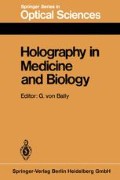Abstract
The generation of equal-height contour lines is a promising method for the complete, accurate, and form-fitting description of objects with irregular, threedimensional shapes. This problem exists in the field of medicine, because traditional measurements of human body forms with tape and calipers are no more sufficient. The increasing importance of such methods is indicated by the many attempts reported in the past [1]. But in most cases the point coordinates of the body surface had to be extracted before plotting the contour lines. This procedure was time-consuming or needed a complex equipment. None of them was accepted in clinical practice. A great interest arose in all methods, which are capable of generating contour lines as a first “integral” result - without the need of any analytical handling. One of them, the “Moiré-Topography” of TAKASAKI, was the starting point of a great number of studies for the determination of body volume, surface area and shape. Moiré - contouring is used for the evaluation of the face, of teeth and feet as well as for whole body photography in radiology and orthopedics [2, 3, 4, 5, 6]. Especially in orthopedics there is an increasing demand for description, documentation and evaluation of definite statements of structural abnormities and obvious asymmetries of the human body in the treatment of scoliosis [7, 8, 9, 10].
Access this chapter
Tax calculation will be finalised at checkout
Purchases are for personal use only
Preview
Unable to display preview. Download preview PDF.
Summary
R.E. Herron: Stereophotogrammetry in Biology and Medicine. Proc.XII Congr. Int. Soc. Photogr. (1972) Ottawa.
E. Kanazawa, H. Kamiishi: Evaluation of Facial Osteotomy with the aid of Moire Contourography. J. Max.-fac. Surg. 6 (1978) 233.
W. Holler: Vergleichende Untersuchungen der oberen ersten Molaren bei Wolf (canis lupus lupus), Haushund (canis familiaris-Dobermann) und Goldschakal(canis aureu) mit Hilfe der Moiré-Topographie. Säugetierkundliche Mitt. 26 (1978) 131.
G. Windischbauer, G. Keck, A. Cabaj: Moiré-topographische Verfahren in der Medizin: Ein Podometer zur Dokumentierung von krankhaften Fußstellungen. Orthop.-Technik (1977) 7.
W. Binder, A. Cabaj, K.H. Kärcher, G. Windischbauer: Herstellung von Gewebeausgleichsfiltern für große Flächen bei Hodgkin-Bestrahlung mit Hilfe der Moiré-Technik. Strahlenth. 153 (1977) 82.
H. Neugebauer, G. Windischbauer: Die Moiré-topographische Dokumentation von Haltungsformen und Wirbelsäulenerkrankungen. Biom. Technik. 23 (1978).
B. Drerup: Eine Apparatur zur Dokumentation von Erkrankungen des Haltungs-und Bewegungsapparates durch Moiré-Topographie. Int. Bericht Univ. Münster (1977).
B. Drerup: Anwendung der Moiré-Topographie zur Diagnose und Dokumentation von Fehlbildungen des Rumpfes. Z. Orthp. 116 (1978) 789.
H. Neugebauer, G. Keck, G. Windischbauer: Die Moiré-topographische Dokumentation der Wirbelsäule und des Rückens. Öst. Ärztez. (1978) Nr. 12.
St. Willner: Moiré-Topography: Method for three dimensional study of asymmetries of the human back. Inf. Fa. Camp., Helsingborg, Sweden.
H. Takasaki: Moiré-Topography. Appl. Opt. 9 (1970) 845.
G. Windischbauer: Oberflächenvermessung des menschlichen und tierischen Körpers mit Hilfe von Moiré-Figuren. Proc. 1st Biophys. Cong. 6 (1971) 512 Baden/Vienna.
C.A. Miles, B.S. Speight: Recording the shape of animals by a Moiré method. J. Phys. E. 8 (1875) 773.
G. Windischbauer, A. Cabaj, G. Keck: TV-Moiré-Topography. Wiss. Berichte Tag. Biomed. Techn. in Österr. (1976) 177, Graz.
J. Hormiére, E. Mathieu: Reference plane orientation using optoelectronic methods in Moiré contour lining. Opt. Comm. 19 (1976) 37, Nr.1.
G. Basse: Moiré-Methoden zur Erzeugung von Höhenschichtlinien mit asymmetrischen Profilen. Diss. Univ. Hamburg (1967).
R. Finsterwalder, W. Hofmann: Photogrammetry. Walter de Gruyter & Co, Berlin (1968)
Author information
Authors and Affiliations
Editor information
Editors and Affiliations
Rights and permissions
Copyright information
© 1979 Springer-Verlag Berlin Heidelberg
About this paper
Cite this paper
Windischbauer, G. (1979). Problems of Image Evaluation in Orthopedics Using Moiré Figures. In: von Bally, G. (eds) Holography in Medicine and Biology. Springer Series in Optical Sciences, vol 18. Springer, Berlin, Heidelberg. https://doi.org/10.1007/978-3-540-38961-3_9
Download citation
DOI: https://doi.org/10.1007/978-3-540-38961-3_9
Publisher Name: Springer, Berlin, Heidelberg
Print ISBN: 978-3-662-15811-1
Online ISBN: 978-3-540-38961-3
eBook Packages: Springer Book Archive

